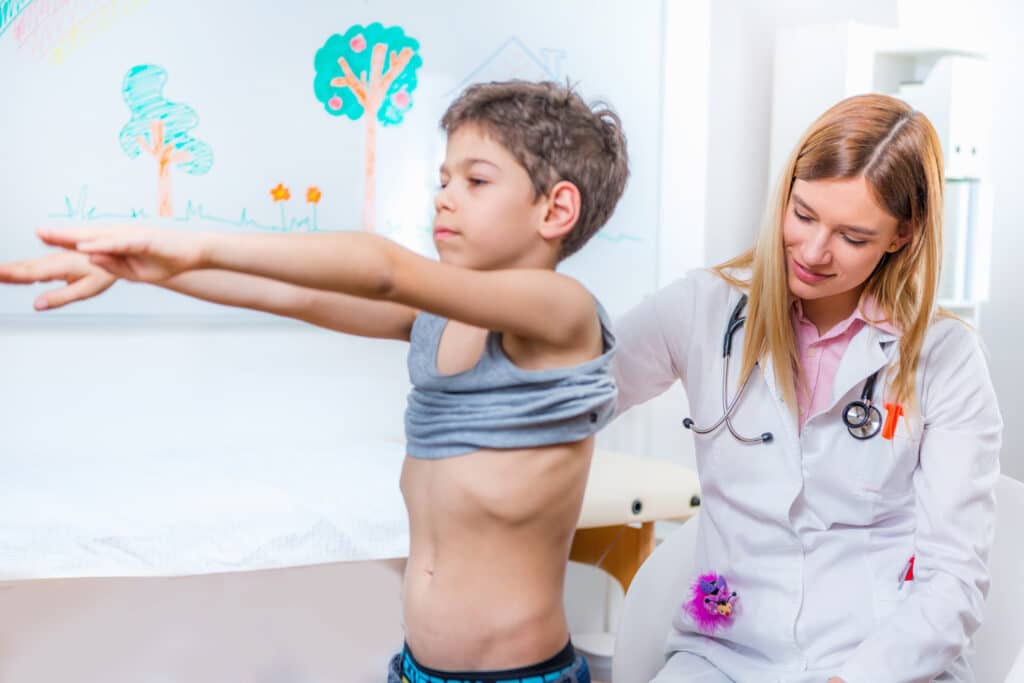Scoliosis, a condition characterized by an abnormal curvature of the spine, is often detected during childhood or adolescence. To identify scoliosis early is crucial to ensure effective treatment and to prevent the condition from worsening. In this article, we will explore how scoliosis is screened, the importance of early detection, and the steps parents and caregivers can take to ensure the best outcomes for children.
Understanding Scoliosis Screening
Scoliosis screening is a standard part of the annual well visit for children, often conducted by pediatricians before the summer break. During this visit, a pediatrician performs a simple test where the child bends forward to touch their toes. This position allows the doctor to visually assess the spine’s alignment. For greater accuracy, some pediatricians use a tool called a scoliometer, which measures the degree of spinal curvature.
In many states, scoliosis screenings are mandated in schools, typically performed by gym teachers or school nurses. These screenings vary by state, but the goal is consistent: to identify potential cases of scoliosis early. Early detection can prevent the need for surgery in most cases, as research shows that timely intervention can halt or slow progression.
The Importance of Early Detection
Scoliosis is a progressive condition, meaning that a mild curvature at a young age can worsen over time if left untreated. Children as young as 10 or 11 years old may develop scoliosis, which can progress significantly during their growth spurts. Identifying scoliosis early allows for non-invasive treatments, such as exercises, which are highly effective for smaller curves. These early interventions can often eliminate the need for bracing or surgery.
Types of Scoliosis in Children
There are three primary types of scoliosis seen in children:
- Infantile Idiopathic Scoliosis: Occurs from birth to age three.
- Juvenile Idiopathic Scoliosis: Affects children between the ages of three and 10.
- Adolescent Idiopathic Scoliosis: The most common type, occurring between ages 10 and 18.
“Idiopathic” means there is no single known cause. Approximately 80% of scoliosis cases fall under the adolescent idiopathic category. This type is the focus of school screenings due to its prevalence and the rapid growth experienced during adolescence, which can exacerbate the condition.
Why Girls Are More Affected
Research shows that while small spinal curves are equally common in boys and girls, larger curves are significantly more prevalent in girls. Studies suggest that large curves are seven to 10 times more likely to occur in girls. The primary reason is that girls experience their growth spurts earlier, around age 10, whereas boys typically have their growth spurts around age 12. During this time, girls’ postural control mechanisms may not be fully developed, making them more susceptible to scoliosis progression.
Variability in Screening Across States
As of recent findings, 37 out of 50 states mandate scoliosis screenings in schools. The timing and implementation of these screenings vary, but they are generally conducted during middle school years when children are most at risk for developing scoliosis. School nurses typically perform these screenings by asking the child to bend forward and visually assessing their spine. While effective for detecting significant curves, this method may miss mild cases, especially those affecting the lower back.
Comprehensive Scoliosis Screening Techniques
At the Strauss Method, scoliosis screenings go beyond the basic forward-bending test. In addition to using a scoliometer, digital photography is employed to identify signs such as:
- Uneven shoulders (one higher than the other)
- Asymmetrical waistlines (one side indented, the other flat)
- Prominent shoulder blades
- Unequal arm lengths when hanging at the sides
- Hips that are uneven or one protruding more than the other
If these indicators suggest scoliosis, a single screening X-ray is taken to confirm the diagnosis. X-rays remain the gold standard for diagnosing scoliosis, even in mild cases.
Key Signs to Watch For
Parents should be vigilant for the following signs of scoliosis in their child:
- Shoulder Blade Asymmetry: One shoulder blade appearing more prominent than the other during the forward-bending test.
- Waistline Discrepancy: One side of the waist being more indented than the other.
- Uneven Shoulders: Noticeable difference in shoulder heights.
- Hip Misalignment: One hip sticking out more or appearing higher than the other.
- Arm Length Discrepancy: Uneven arm hanging due to shoulder rotation.
These signs should prompt a visit to the pediatrician for further evaluation and potentially an X-ray.
The Case for Early Intervention
In some cases, pediatricians may advise a “watch and wait” approach for mild scoliosis. However, this strategy may allow the curve to worsen before treatment begins. At Strauss Method, a proactive approach is preferred. Starting a customized exercise program immediately can reduce the curve size and prevent progression. Early intervention is critical to avoid the need for bracing or surgical intervention in the future.
How to Identify Scoliosis Early – Conclusion
Identifying scoliosis early is vital for effective management and treatment. Regular screenings at pediatric visits and school programs play an essential role in detecting this condition. Parents should also remain vigilant for physical signs of scoliosis and advocate for early intervention if necessary. With timely action, most cases of scoliosis can be successfully managed, allowing children to lead healthy, active lives.
